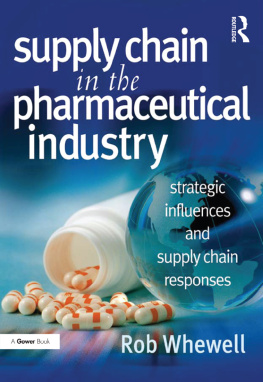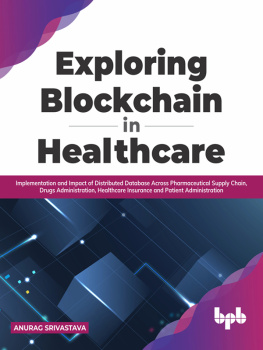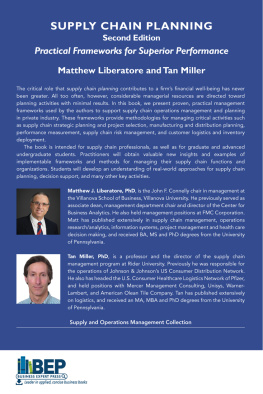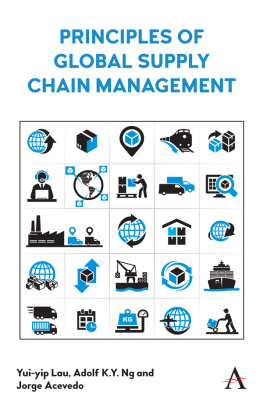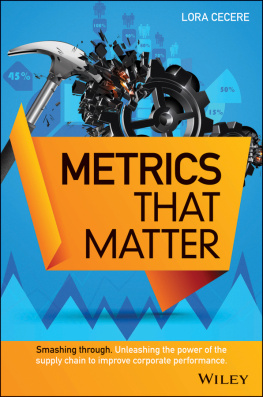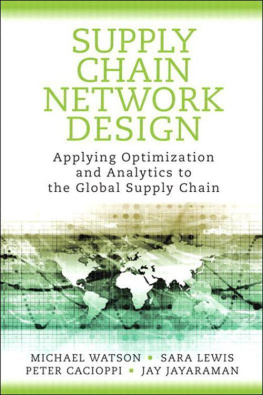Supply Chain in the Pharmaceutical Industry
Supply Chain in the Pharmaceutical Industry
Strategic Influences and Supply Chain Responses
ROB WHEWELL

First published 2010 by Gower Publishing
Published 2016 by Routledge
2 Park Square, Milton Park, Abingdon, Oxon OX14 4RN
711 Third Avenue, New York, NY 10017, USA
Routledge is an imprint of the Taylor & Francis Group, an informa business
Copyright Rob Whewell 2010
Rob Whewell has asserted his moral right under the Copyright, Designs and Patents Act, 1988, to be identified as the author of this work.
All rights reserved. No part of this book may be reprinted or reproduced or utilised in any form or by any electronic, mechanical, or other means, now known or hereafter invented, including photocopying and recording, or in any information storage or retrieval system, without permission in writing from the publishers.
Notice:
Product or corporate names may be trademarks or registered trademarks, and are used only for identification and explanation without intent to infringe.
British Library Cataloguing in Publication Data
Whewell, Rob.
Supply chain in the pharmaceutical industry : strategic influences and supply chain responses.
1. Pharmaceutical industry--Management. 2. Business logistics.
I. Title
338.476151-dc22
Library of Congress Cataloging-in-Publication Data
Whewell, Rob.
Supply chain in the pharmaceutical industry : strategic influences and supply chain responses / by Rob Whewell.
p. cm.
Includes bibliographical references and index.
ISBN 978-0-566-08695-3 (hardcover)
1. Pharmaceutical industry--Materials management. 2. Pharmaceutical industry--Costs. 3. Pharmaceutical industry--Customer services. 4. Business logistics. 5. Medical supplies. 6. Drugs. I. Title.
[DNLM: 1. Economics, Pharmaceutical. 2. Technology, Pharmaceutical--economics. 3. Cost Control. QV 736 W569s 2009]
HD9665.5.W48 2009
615.10687--dc22
2009010407
ISBN: 978-0-566-08695-3 (hbk)
ISBN: 978-1-3156-1133-4 (ebk)
List of Figures
List of Tables
1
The Role of Technology in the Supply Chain
Technological progress has been crucial to, and is the reason for, major advances in healthcare; it is often when multiple technologies are juxtaposed that the most dramatic, breakthrough results are achieved. These interactions mean that the processes through which healthcare is delivered are complex, requiring careful design and management. The shape that healthcare processes take has a crucial impact not only on the quality of the resulting service provision but also on the way in which suppliers of healthcare products will need to operate to make the most of their opportunities.
In this initial chapter we identify some of the advances in technology that have either directly or indirectly resulted in a step change in the healthcare environment, as well as the availability or the capability to provide and deliver improved services.
Historical Review
Throughout history the development and application of technology has enabled progress in healthcare provision. The major technology platforms that have advanced healthcare may be grouped under four main headings:
1. Environmental improvements.
2. Pharmaceuticals and chemicals.
3. Diagnostic technologies.
4. Medical devices.
All of these categories have been essential to the continuation of progress in healthcare provision. They are interrelated. Treatment of an infection with advanced antibiotics is likely to be fruitless if the patient returns home to living conditions that are unsanitary.
Without proper diagnostic tools, choice of appropriate therapy is an art, not a science. Improvements in the devices and techniques used to administer drugs and healthcare improvements have arguably been as important as improvements in the drugs or devices themselves. Devices such as dentures, prosthetic limbs, dialysis equipment and contact lenses have had a profound impact on the lifestyle and well-being of patients.
Environmental Improvements
Technology has enhanced healthcare by improving environmental and social conditions in such a way as to prevent disease from occurring or spreading. Civil engineering has played a much more central role in improving health than might be suspected at first sight. General housing and living conditions support and complement any treatment that patients receive in hospital or at clinics. While living in unsanitary conditions, not only is the patient likely to relapse, but also the infection is highly likely to spread. It is generally accepted that, with regret for the loss of life, the Great Fire of London in 1666 could be considered a long-term benefit from the point of view that it destroyed the slum dwellings that had formerly incubated the plague.
These, sadly, are not just historical occurrences. The biggest threat to the human population of New Orleans after the devastating floods of September 2005 caused by hurricane Katrina was infected water. Water supplies were contaminated with oil from damaged refineries, sewage from treatment plants and the rotting corpses of animals and humans floating for days in the putrid floodwaters. Similarly in Pakistan after the massive earthquake that made millions homeless later in the same year and laid waste to tens of villages and hundreds of homes, the immediate concerns for relief agencies were to deliver shelter, in the form of tents, fresh water, by way of portable desalination equipment; and chlorination materials, food supplies and basic medicines.
The following are examples of technologies that have played a key role in health improvement over the years:
In the home, improved drainage systems and appliances such as lavatories, in particular the U-bend trap, have allowed much higher levels of hygiene to be attained with relatively little effort. In the clinical setting sophisticated air conditioning and the emergence of High Efficiency Particulate Air Filters (HEPA) allow medical procedures to take place in a sterile environment. In this context we should note, however, that technology is not sufficient on its own; it must be used in the context of appropriate processes.
The prevalence of methicillin-resistant Staphylococcus aureus (MRSA) in hospitals shows that even in environments equipped with the latest technologies, infection can spread if basic cleanliness is not maintained. Education in basic hygiene is considered to be the main variable parameter here. Washing hands properly with soap (for example after using the toilet), washing or disposing of contaminated clothing or bedding, and sterilising equipment prior to use are all basic and essential factors. The World Health Organization (WHO) believes that growing levels of drug resistance threaten to erode medical advances of recent decades. In the USA, nosocomial MRSA infection rates have nearly doubled to over 60 per cent since around 2000. Unless antibiotic resistance problems are detected as they emerge, and actions are taken to contain them, the world could be faced with previously treatable diseases becoming untreatable. According to the United States Food and Drug Administration (FDA) about 70 percent of bacteria that cause infections in hospitals are resistant to at least one of the drugs most commonly used to treat infections.
The engineering of the water supply has been critical to reducing infection. In the nineteenth century, cholera outbreaks were common in cities such as London until it was realised that they were triggered by contamination of the water supply with sewage. The technology that was needed to prevent this contamination was relatively straightforward once the cause was understood. The development of the flush toilet and of sewage systems played a large part (see ).
Next page
